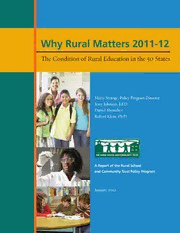
ERIC ED528634: Why Rural Matters 2011-12: The Condition of Rural Education in the 50 States. A Report of the Rural School and Community Trust Policy Program PDF
Preview ERIC ED528634: Why Rural Matters 2011-12: The Condition of Rural Education in the 50 States. A Report of the Rural School and Community Trust Policy Program
Why Rural Matters 2011-12 The Condition of Rural Education in the 50 States MartyStrange,PolicyProgramDirector JerryJohnson,Ed.D. DanielShowalter RobertKlein,Ph.D. A Report of the Rural School and Community Trust Policy Program January2012 Why Rural Matters 2011-12 The Condition of Rural Education in the 50 States MartyStrange,PolicyProgramDirector JerryJohnson,Ed.D. DanielShowalter RobertKlein,Ph.D. A Report of the Rural School and Community Trust Policy Program January2012 TheRuralSchoolandCommunityTrustisanationalnonprofitorganization addressingthecrucialrelationshipbetweengoodschoolsandthriving communities.Ourmissionistohelpruralschoolsandcommunitiesgrowbetter together.Workinginsomeofthepoorest,mostchallengingplaces,theRural Trustinvolvesyoungpeopleinlearninglinkedtotheircommunities,improvesthe qualityofteachingandschoolleadership,andadvocatesinavarietyofwaysfor appropriatestateandfederaleducationalpoliciesincludingeffortstoensure equitableandadequateresourcesforruralschools. Why Rural Matters 2011-12 TheConditionofRuralEducationinthe50States ©2012bytheRuralSchoolandCommunityTrust Allrightsreserved PrintedintheUnitedStatesofAmerica ExceptaspermittedundertheUnitedStatesCopyrightActof1976,nopartofthis publicationmaybereproducedordistributedinanyformorbyanymeansorstored inadatabaseorretrievalsystemwithoutpriorwrittenpermissionofthepublisher. TheRuralSchoolandCommunityTrustexpressesappreciationtotheVerizon FoundationforfinancialsupporttopublishWhyRuralMatters2011-12. APDFversionofthisreportisavailableattheRuralTrust’swebsite: www.ruraledu.org RuralSchoolandCommunityTrust 4455ConnecticutAve.,NW,Suite310 Washington,DC20008 (202)822-3919 Contents Introduction .................................................................................1 TheData ..........................................................................1 GaugingRuralEducationinthe50States .............................................1 NewandRevisedGaugesandIndicators .............................................3 NotesonReportMethodology ......................................................4 Results .......................................................................................5 ImportanceGauge..................................................................5 StudentandFamilyDiversityGauge .................................................7 EducationalPolicyContextGauge ...................................................9 EducationalOutcomesGauge ......................................................13 LongitudinalGauge ................................................................15 RuralEducationPriorityGauge .....................................................17 ConclusionsandImplications .............................................................19 TheSouthernHegemony ..........................................................19 TheSpecialEducationandPovertyDichotomy ......................................20 SpendingandFiscalCapacity ......................................................20 TheBottomLine ..................................................................21 MapsofStateRankings ..................................................................22 (alphabeticalbystate) .........................................28 State-by-StateResults (rankingsofall50statesoneachindicator) Indicators ImportanceGaugeIndicators ......................................................78 StudentandFamilyDiversityGaugeIndicators ......................................83 EducationalPolicyContextGaugeIndicators ........................................88 EducationalOutcomesGaugeIndicators ............................................93 LongitudinalGaugeIndicators .....................................................98 Introduction W hyRuralMatters2011-12isthesixthinaseries schoolsandthepercentchangeinnumberofruralschools. ofbiennialreportsanalyzingthecontextsand Thisconsistencyisparticularlyimportantbecausepolicy conditionsofruraleducationineachofthe50 decisionsimpactingruraleducation(e.g.,REAPfunding) statesandcallingattentiontotheneedforpolicymakersto aremadeusingdistrict-leveldesignationsofruralstatus. addressruraleducationissuesintheirrespectivestates. Becauseourlongitudinalgaugeincludesindicatorsthatuse Whileitisthesixthinaseries,thisreportisnotsimplyan datafromyearspriorto2006(whenthenewlocalecode updatingofdatafromearliereditions.Onthecontrary, systemwasintroduced)itwasnecessarytoback-codein fromonereporttothenext,wehavedeliberatelyalteredthe ordertoassignlocalestoschooldistrictsforthoseearlier statisticalindicatorsandgaugestocallattentiontothevari- years.Todoso,werecodedtheearlierdatafollowingthe abilityandcomplexityofruraleducation.Ourintentin samebasicmethodologyasthecurrentruralclassification thesereportsisnot—asitisinmanystate-by-stateanaly- system.Underthecurrentsystem,adistrict’slocalecodeis ses—tocomparestatesintermsoftheirdifferingratesof determinedbythelocalecategory(city[locales11-13],sub- progresstowardanarbitrarygoal.Rather,ourintentis(1) urb[locales21-23],town[locales31-33],andrural[locales toprovideinformationandanalysesthathighlightthepri- 41-43])oftheschool(s)whereapluralityofstudentsare oritypolicyneedsofruralpublicschoolsandthecommuni- enrolled.Whenwecompareruralandnon-ruralschool tiestheyserve,and(2)todescribethecomplexityofrural districtsusingthe2008-09data,wearecomparing(1)dis- contextsinwaysthatcanhelppolicymakersbetterunder- trictswherethetotalnumberofstudentsenrolledin standthechallengesfacedbytheirconstituenciesandfor- schoolsdesignatedasrural(locale41,42,or43)isgreater mulatepoliciesthatareresponsivetothosechallenges. thanthenumberofstudentsenrolledinanyoftheother threelocalecategories(city,suburb,ortown)with(2)dis- In2008-09(theschoolyearusedinthisreport),9,628,501 trictswherethetotalnumberofstudentsenrolledinany publicschoolstudentswereenrolledinruralschooldis- oneoftheotherthreecategories(city,suburb,ortown)is tricts—20%ofthenation’stotalpublicschoolenrollment. greaterthanthetotalnumberofstudentsenrolledinrural Meetingtheneedsofmorethan9.6millionchildrenisa schools.Toidentifyruraldistrictsforyearspriorto2006, challengethatdemandsanddeservestheattentionofa wefollowedthesameprocedureusingtheschool-level nation.Itisalsoachallengethatcallsforlookingatissues localecodesthatwereineffectatthattime.Thus,foryears frommultipleperspectivesinordertodevelopinformed priorto2006,ruraldistrictsarethosewherethetotal understandingsthatmovebeyondoverlysimplisticnotions numberofstudentsattendingschoolsdesignatedaslocale7 aboutruralschoolsandthecommunitiestheyserve. orlocale8(i.e.,rural)isgreaterthanthetotalnumberof studentsattendingschoolsinanyoneoftheotherthree The Data categories(i.e.,locales1and2[city],locales3and4[urban fringe],orlocales5and6[town]). ThedatausedforWhyRuralMatters20011-12werecom- piledfrominformationcollectedandmaintainedbythe Asinearlierversionsofthereport,WhyRuralMatters NationalCenterforEducationStatistics(NCES)andthe 2011-12usesdataonlyforregularlocaleducationagencies U.S.CensusBureau.Alldatausedhereareavailabletothe (localschooldistrictsandlocalschooldistrictcomponents generalpublicandmaybedownloadedintabularformats. ofsupervisoryunions).Thusweexcludecharterschool- onlydistrictsandspecializedstate-andfederally-directed Todefine“rural,”weusedthe12-itemurban-centricNCES educationagenciesfocusedprimarilyonvocational,special, localecodesystemreleasedin2006. Ruralschoolsanddis- oralternativeeducation. trictsusedinthereportarethosedesignatedwithlocale codes41(ruralfringe),42(ruraldistant),or43(rural remote).WhileearlyversionsofWhyRuralMatters(i.e., Gauging Rural Education thoseprecedingthe2009version)usedacombinationof in the 50 States school-levelanddistrict-leveldata,improvementsinthe Weframethereportaroundfivegaugesmeasuringforeach urban-centriclocalecodesystem(specifically,assigningdis- state(1)theImportanceofruraleducation,(2)theDiver- trict-levellocalebaseduponthelocalewheretheplurality sityofruralstudentsandtheirfamilies,(3)theEducational ofstudentsinthedistrictattendschool)havemadeitpos- PolicyContextimpactingruralschools,(4)theEducational sibleforustobeconsistentandusedistrictsastheunitof Outcomesofstudentsinruralschoolsineachstate,and(5) analysisforallindicatorsexceptforthepercentageofrural theLongitudinalchangesthathaveoccurredineachstate WHY RURAL MATTERS 2011-12 1 incertainkeyareas.Eachgaugeiscomprisedoffiveequally ablebecauseoftheirpotentialtomislead.Thepossibilities weightedindicators—thus25indicatorsinall.Instances forassemblingindicatorstodescribethecontext,conditions, wheredatawerenotavailablearedenotedwithN/A. andoutcomesofruralschoolsandcommunitiesarevirtually unlimited.WeacknowledgethecomplexityofruralAmerica Thehighertherankingonagauge,themoreimportantor generallyandof50individualstatesystemsofpubliceduca- themoreurgentruraleducationmattersareinaparticular tion,andwerecognizethatperspectivesofferedbytheindi- state. catorsusedhererepresentonlyoneofmanygoodwaysof understandingruraleducationintheU.S. Thegaugesandtheircomponentindicatorsareasfollows: Toillustratetheproblematicnatureofcomparingastate’s ImportanceGauge rankingononereportwiththesamestate’srankingin anotheryear’sreport,considerWashington,astatethat (cid:1)Percentruralschools ranked23rdintermsofoverallruraleducationpriorityin (cid:1)Percentsmallruralschooldistricts 2009(withinthesecondquartile,whichwetermedthe (cid:1)Percentruralstudents “Major”prioritycategory).Bycontrast,inthe2011report, (cid:1)Numberofruralstudents Washingtonranksinthefourthquartileas42ndintermsof (cid:1)Percentofstateeducationfundstoruraldistricts ruraleducationpriority,achangepartlyduetothenewfifth gauge(Washingtonwasrankedinthesecondquartileonthe StudentandFamilyDiversityGauge ConcentratedPovertygauge,butranksinthefourthquartile (cid:1)Percentruralminoritystudents ontheLongitudinalgauge).TointerpretWashington’slarge (cid:1)PercentruralELLstudents dropinruraleducationpriorityconcernasa“success”might (cid:1)PercentruralIEPstudents meanoverlookingtheissuesofseverepovertythatmaystill (cid:1)Percentruralstudentpoverty existinruralpocketsaroundthestate. (cid:1)Percentruralhouseholdmobility Indiana,ontheotherhand,isastatethatmovedfrom EducationalPolicyContextGauge belowthenationalmedianat32ndintermsofoverallrural (cid:1)Ruralinstructionalexpendituresperpupil educationprioritytoarankingof18th(withinthesecond (cid:1)Ratioofinstructionaltotransportationexpenditures quartile,whichwetermedthe“Major”prioritycategory). (cid:1)Medianorganizationalscale Muchofthisshiftbetweenthetwoversionsofthereport (cid:1)Staterevenuetoschoolsperlocaldollar canbeattributedtothechangeingauges.Indianaranked (cid:1)SalaryexpendituresperinstructionalFTE inthethirdquartileontheConcentratedPovertygauge, buthasbeenoneofthemostvolatilestatesintermsof EducationalOutcomesGauge Longitudinalchangeinruralareas.Ratherthaninterpret- (cid:1)Ruralhighschoolgraduationrate ingthischangeasIndiana“climbing14places,”attention (cid:1)Ruralgrade4NAEPscores(math) shouldbefocusedonthefactthatIndiana’sstudentpopu- (cid:1)Ruralgrade4NAEPscores(reading) lationisincreasinglyrural,andthatthepovertyrateis (cid:1)Ruralgrade8NAEPscores(math) growingamongtheseruralstudents.Makinggoodpolicy (cid:1)Ruralgrade8NAEPscores(reading) choicesforAmerica’sruralschoolchildrenrequirescare- fullyconsideringthefullstateprofileandthestorytoldby LongitudinalGauge eachindicator. (cid:1) Increaseinabsoluteruralstudentenrollment(1999-00 to2008-09) Foreachofthefivegauges,weaddedthestaterankingson (cid:1) Percentchangeinnumberofruralstudents(1999-00 eachindicatorandthendividedbythenumberofindica- to2008-09) torstoproduceanaveragegaugeranking.iUsingthatgauge (cid:1) PercentchangeinnumberofruralHispanicstudents ranking,wethenorganizethestatesintoquartilesthat (1999-00to2008-09) describetheirrelativepositionwithregardtootherstates (cid:1) Changeinpercentruralstudentpoverty(1999-00to onthatparticulargauge.FortheImportance,Educational 2008-09) PolicyContext,andLongitudinalgauges,thefourquartiles (cid:1) Changeinruralstudentsasapercentageofallstudents arelabeled“Notable,”“Important,”VeryImportant,”and (1999-00to2008-09) Whilesomeoftheindicatorsusedinthisreportarethe i Gaugerankingsarenotcalculatedforstatesthathavefewerthan sameasinpreviousversions,severalarenotandsooverall threeofthefiveindicatorrankingspresent.Theseinstancesare year-by-yearcomparisonsofastate’srankingarenotadvis- denotedwithanasteriskandaclarifyingnote. 2 WHY RURAL MATTERS 2011-12 “Crucial.”FortheStudentandFamilyDiversityandEduca- theConcentratedPovertyGaugewiththeLongitudinal tionalOutcomesgauges,thefourquartilesarelabeled Gauge.However,therehavebeenafewotherchanges “Fair,”“Serious,”“Critical,”and“Urgent.”Itisimportantto madeamongtheindicators,andthesearedescribedbelow. notethatthesecategoriesareintendedtobedescriptivein onlythemostgeneralway.Thereislittlesubstantivediffer- TheEducationalPolicyContextGaugecontainsoneminor encebetweena“Crucial”rankingof13anda“VeryImpor- adjustment:thenewindicator“staterevenuetoschoolsper tant”rankingof14. localdollar”replacesthe2009WhyRuralMattersindica- tor“inequalityinstateandlocalrevenueperpupil.”This Lastly,wecombinedthefiveaveragegaugerankingsto improvedindicatormeasurestheextenttowhichrural determineanoverallaveragerankingii,whichwetermthe schoolfundscomefromthestateversuslocalcommunities, RuralEducationPriorityranking. withameasureof$1indicatingequalamountsofmoney comingfromthestateandlocalcommunities,greaterthan Certainstateshaveretainedahighruraleducationpriority $1indicatingmorestatethanlocalsupportandlessthan$1 rankingfromyeartoyeardespitethefactthatweusedif- indicatingmorelocalthanstatesupport.Ruralschoolsthat ferentindicatorsandgauges.Forthesestates,ruraleduca- relymoreheavilyonlocalsupportaresubjecttogreater tionisapparentlybothimportantandinurgentneedof variationinsupportbasedonlocaleconomicconditions, attentionnomatterhowyoulookatit. propertytaxbase,andindustrialtaxrevenues.Suchstates arelikelytohavegreaterdisparitiesfromonelocationto Onefinalcautionfromearlierreportsisworthrepeating. anotherbasedonlocalconditions. Becausewereportstate-leveldataformostindicators,our analysesdonotrevealthesubstantialvariationinruralcon- TheEducationalOutcomesGaugewasrevisedconsiderably textsandconditionswithinmanystates.Thus,whilean fromthe2009report,droppingtwoindicatorscharacteriz- indicatorrepresentstheaverageforaparticularstate,in ingruralstudents’NCLBproficiencyinreadingandmath realitytheremayberuralregionswithinthestatethatdif- andtwocomposite(mathandreadingcombinedNAEP ferconsiderablyfromthestateaverage.Thisisespecially scoresateachoftwogradelevels)andreplacingthem4 trueforindicatorslikepovertyandELLstatus,sincedemo- NAEPscoresthatseparatelyreportmathandreading graphiccharacteristicssuchasthesetendnottobedistrib- resultsatgradefourandgradeeight.Therationaleforthis utedevenlyacrossastatebutareconcentratedvariouslyin changewastwofold:(1)statesvarywidelyintheirstan- specificcommunitieswithinthestate.Inthecaseofsuch dardsforproficiency,makingtheNCLBdatadifficultto indicators,thestatewideaveragemaynotreflectthereality analyzeandreport,and(2)considerablevariationinNAEP inanyonespecificplace,withfarhigherratesinsome scoresacrossgradelevelsandsubjectareastronglysug- placesandfarlowerratesinothers.Itisourhopeinsuch gestedthevalueinconsideringtheindividualscores(i.e., casesthatthepresentationofstateaveragedindicatorswill grade4reading,grade4math,grade8reading,grade8 promptmorerefineddiscussionsandleadtobetterunder- math)separately. standingsofallruralareas. TheLongitudinalGaugeappearsforthefirsttimeinWhy New and Revised Gauges RuralMatters2011-12.Itusesfiveindicatorstocharacterize and Indicators changesoccurringovertime(absolutechangeinthenum- berofruralstudents,percentchangeinthenumberofrural Inanefforttorefineandbetterreflectourthinkingabout students,percentchangeinthenumberofruralHispanic thecontextsandcharacteristicsofruraleducation,wemade students,changeinpercentageofruralpoverty,andchange somechangesfrompreviousreportswithregardtothe inruralstudentsasapercentageofallstudents).Foreach selectionandconfigurationofindicatorsandgaugesused. indicator,wecompareddatafromitsfirstyearofavailability WhyRuralMatters2009included25indicatorsorganized to2008-09data.Twoindicatorsinparticular—changein into5gauges:Importance(5indicators),StudentandFam- ruralHispanicpopulationsandruralpoverty—showedspo- ilyDiversity(5),EducationalPolicyContext,(5),Educa- radicstatereportingatfirst,sowecompared2008-09data tionalOutcome(5),andConcentratedPoverty(5).The withthefirstyearofreliabledatafromeachstate.Onthe 2011reportalsoincludes5gauges,eachcomprising5indi- otherthreeindicators,wewereabletouse1987-88datato cators(foratotalof25indicators).Themajordifference understandtwodecadesofchangeinthekeyindicators. fromthepreviousreporttothisoneisthereplacementof Thelocalecodingsystemchangedsignificantlyin2006, ii Priorityrankingsarenotcalculatedforstatesthathavefewerthan makingitinaccuratetocompareraw“rural”datacollected fourofthefiveindicatorrankingspresent.Theseinstancesare underthetwodistinctdefinitions.Onesolutionwould denotedwithanasteriskandaclarifyingnote. WHY RURAL MATTERS 2011-12 3 havebeentousethe2005-06schoolyeardataasthemost assignedtoLouisianabasedonitsrankingof14thonthe recentdataforthelongitudinalcomparisons.However,we samegauge. feltthatthiswouldnotprovideanadequateexaminationof currenttrends,especiallywithregardstotheburgeoning Second,againinthisreportweuseregionaltermsloosely. ruralHispanicpopulation.Thus,tospanasmanyyearsas Now,asthen,theintentisnottoconfuseorobscuremean- possiblewhilepreservingconsistency,werecodedtheear- ings,buttorecognizenuancesinregionalidentitiesandto lierdataaccordingtothecurrentruralclassificationsystem. bestrepresentthecontextswithinwhichwearediscussing Inotherwords,foranygivenyear,adistrict’slocalewas specificrelationshipsbetweenindividualstatesandshared determinedbywhichofthefourlocales(city,suburb,town, geographicandculturalcharacteristics.Withthisintent,a rural)contributedthemoststudents.Forexample,adis- statelikeOklahomamaybereferredtoasaSouthern trictwith3,000studentsinsuburbanschools,2,000stu- PlainsstateinsomecontextsandasaSouthwesternstatein dentsintownschools,and4,000studentsinruralschools others.ThatisbecauseOklahomaispartofregionalpat- wouldbecodedasaruraldistrictforthepurposesofthis ternsthatincludeSouthernPlainsstateslikeKansasand comparison. Colorado,butitisalsopartofregionalpatternsthat includeSouthwesternstateslikeNewMexico. Notes on Report Methodology Third,therankingsystemshouldnotbeinterpretedtosug- ReadersfamiliarwithearliereditionsofWhyRural gestthatruraleducationinlow-prioritystatesdoesnot Matterswillnotethefollowingconsiderationswhenread- deserveattentionfrompolicymakers.Indeed,everystate ingthe2011report. faceschallengesinprovidingahigh-qualityeducational experienceforallchildren.Thehighestprioritystatesare First,thequartilecategoriesusedtodescribestates’posi- presentedassuchbecausetheyarestateswherekeyfactors tiononthecontinuumfrom1-50arearbitrary,andare thatimpacttheschoolingprocessconvergetopresentthe usedmerelyasaconvenientwaytogroupstatesintosmaller mostextremechallengestoschoolingoutcomes,andso unitstofacilitatediscussionofpatternsintheresults.Thus, suggestthemosturgentandmostcomprehensiveneedfor thereisverylittledifferencebetweenthe“Urgent”label attentionfrompolicymakers. assignedtoMississippibasedonitsrankingof13thonthe StudentandFamilyDiversityGaugeandthe“Critical”label 4 WHY RURAL MATTERS 2011-12 Results Thedataforeachstateandstaterankingsforeachindi- discussedbelow.Toprovidesomecontextandtoaidin catorarepresentedinthechartsandfiguresonpages makingcomparisons,nationallevelresultsarepresentedin 28-77.Theresultsforeachindicatoraresummarizedand Table1. Table 1. National Rural Statistics ImportanceGauge EducationalOutcomesGauge Percentruralschools: 33.0% Ruralhighschoolgraduationrate: 77.5% Percentsmallruraldistricts: 49.9% RuralGrade4NAEPscores(math): 240 Percentruralstudents: 20.2% RuralGrade4NAEPscores(reading): 222 Numberofruralstudents(USMedian=131,129): 9,628,501 RuralGrade8NAEPscores(math): 284 Percentstateeducationfundstoruraldistricts: 20.4% RuralGrade8NAEPscores(reading): 264 StudentandFamilyDiversityGauge LongitudinalGauge Percentruralminoritystudents: 25.8% Changeinabsouteruralenrollment PercentruralELLstudents: 3.7% (median=9,880): 1,735,666 PercentruralIEPstudents: 12.1% Percentchangeinruralenrollment: 22.2% Percentruralstudentpoverty: 41.0% PercentchangeinruralHispanicenrollment: 150.9% Percentruralmobility: 12.7% Changeinpercentruralstudentsinpoverty: 9.8% Changeinruralstudentsasapercentage EducationalPolicyContextGauge ofallstudents: 2.6% Ruralinstructionalexpendituresperpupil: $5,657 Ratioofinstructionaltotransportationexpenditures: $11.06 Medianorganizationalscale(dividedby100): 5,203 Ratioofstaterevenuetolocalrevenue: $1.31 SalaryexpendituresperinstructionalFTE: $56,159 Importance Gauge Wyoming,Arkansas,Oklahoma,WestVirginia,Iowa,Mis- sissippi,NewHampshire,andNorthCarolina)andatleast oneinthreeofallschoolsisruralin15otherstates.Ingen- ImportanceGaugeIndicators Absoluteandrelativemeasuresofthesizeandscopeof eral,stateswithahighpercentageofruralschoolsarethose ruraleducationhelptodefinetheimportanceofruraledu- wheresparsepopulationsand/orchallengingterrainmakeit cationtothewell-beingofthestate’spubliceducationsys- difficulttotransportstudentstoconsolidatedregional temasawhole.Inthissection,wedefineeachofthe schoolsinnon-ruralareas.Predominantlyurbanstateson indicatorsintheImportanceGaugeandsummarizestate theEastandWestcoastsandintheGreatLakesregion andregionalpatternsobservedinthedata.1 havethesmallestpercentagesofruralschools. (cid:1) Percentruralschoolsisthepercentageofregular (cid:1) Percentsmallruralschooldistrictsisthepercentageof elementaryandsecondarypublicschoolsdesignatedas ruralschooldistrictsthatarebelowthemedianenroll- ruralbyNCES. Thehigherthepercentageofschools, mentsizeforallruralschooldistrictsintheU.S.(median thehigherthestateranksontheImportanceGauge. =537students).Thehigherthepercentageofdistricts withenrollmentsbelow537,thehigherthestaterankson Thenationalaverageis33%butstatesvaryconsiderablyon theImportanceGauge. thisindicator,fromalowof6.6%inMassachusettstoa highof78.6%inSouthDakota.Morethanhalfofall Atleasthalfofallruraldistrictsaresmallerthanthe schoolsareruralin15states(inorder,SouthDakota,Mon- nationalruralmedianin22states(Montana,North tana,Vermont,NorthDakota, Maine,Alaska,Nebraska, Dakota,Vermont,Nebraska,SouthDakota,Oklahoma, 1 Hawaiiisexcludedfrommostoftheindicatorsthroughoutthisreportbecauseitsorganizationasasinglestatewidedistrictmakesdistrict- leveldataunavailableforruralcommunities. WHY RURAL MATTERS 2011-12 5 Colorado,California,Alaska,Oregon,Maine,Kansas,New alonehasmoreruralstudentsthantheNorthernand Mexico,Missouri,Washington,Arizona,Idaho,Illinois, SouthernGreatPlainsstatesofMontana,NorthDakota, NewHampshire,Massachusetts,Iowa,andTexas).States SouthDakota,Wyoming,Colorado,Nebraska,Kansas,and withfewornosmallruraldistrictsarelocatedprimarilyin Oklahoma—combined. theSoutheastandMid-Atlantic—regionsthatarecharac- terizedbyconsolidatedcounty-widedistricts.WestVir- Percentageofstateeducationfundsgoingtorural (cid:1) ginia,astatewhereoverhalfoftheschoolsareinrural schoolsrepresentstheproportionofstatePK-12fund- communities,doesnothaveasinglesmallruralschooldis- ingthatgoestoschooldistrictsdesignatedbyNCESas trictthankstoadecadeslongstateefforttoconsolidation rural.Statefundingasdefinedhereincludesallstate- localschoolsincountywideruraldistricts. derivedrevenuesthatareusedfortheday-to-dayopera- tionsofschools(thus,capitalconstruction,debtservice, Percentruralstudentsisameasureoftherelativesizeof andotherlong-termoutlaysareexcluded).Thehigher (cid:1) theruralstudentpopulation,andiscalculatedasthe thepercentageofstatefundsgoingtoruraleducation, numberofpublicschoolstudentsenrolledinruraldis- thehigherthestateranksontheImportanceGauge. tricts,whethertheyattendruralschoolsornot,dividedby thetotalnumberofpublicschoolstudentsinthestate. It’snosurprisethatstatesrankinghighonpercentrural Itexcludesstudentsattendingruralschoolsthatarenot schoolsandpercentruralstudentsalsorankhighonthis locatedindistrictsthatNCESdesignatesasrural.The indicator. Ingeneral,moststatesprovideaslightlydispro- higherthepercentageofruralstudents,thehigherthe portionalamountoffundingperpupiltoruraldistricts stateranksontheImportanceGauge. (basedoncomparingthepercentageofeachstate’sfunding thatgoestoruraldistrictswiththepercentageofthestate’s Justover20%ofallpublicschoolstudentswereenrolledin studentsthatareenrolledinruraldistricts).Thisisproba- districtsclassifiedasrural.Inonlythreestateswereover blybecausemanystateformulastakeintoaccountthe halfthestudentsenrolledinruraldistricts—Mississippi higherfixedcostsperpupilofsmalldistricts,andbecausein (54.7%),Vermont(54.6%)andMaine(52.7%).Inthirteen themostruralstates,ruralpovertylevelsarehigh,another otherstates,overone-thirdofallstudentswereinrural factorconsideredinmanystatefundingformulas.Thisrela- schooldistricts(indescendingorder,NorthCarolina, tionshipbetweenpercentruralstudentsandpercentof SouthDakota,SouthCarolina,Alabama,Tennessee,North statefundingdeterioratesinmoststateswherethepercent- Dakota,Kentucky,WestVirginia,NewHampshire, ageofruralstudentsinverylow,however.Thatmaybe Arkansas,Georgia,Iowa,andMontana).Thesestatesare becauseruralpovertyisrelativelylowinmanyofthese concentratedinfiveregions:NorthernNewEngland,the states,andstatefundingformulasthattakepovertyinto Mid-SouthDelta,theGreatPlains,theSoutheast,and accountwilldeliverlesstoruraldistrictsforthatreason. CentralAppalachia.Stateswiththelowestproportional Andthisrelationshipisnotuniversalamongstateswith ruralenrollmentsareprimarilyurbanstatesontheEast highpercentagesofruralstudents.InMississippi,for CoastandWestCoastandinaridormountainousWestern example,54.7%ofstudentsattendaruralschooldistrictbut stateswherethepopulationresidesmostlyincitiesand only47.2%ofstatefundinggoestothesedistricts.Andonly ruralareasareverysparselypopulated. NewMexicoandLouisianahavehigherratesofruralstu- dentpovertythanMississippi. Numberofruralstudentsisanabsolute—asopposedto (cid:1) relative—measureofthesizeoftheruralstudentpopula- ImportanceGaugeRankings tion.Thefiguregivenforeachstaterepresentsthetotal Togaugetheimportanceofruraleducationtotheoverall numberofstudentsenrolledinpublicschooldistricts educationalsystemineachstate,weaverageeachstate’s designatedasruralbyNCES.Thehighertheenrollment rankingontheindividualindicators,givingequalweightto number,thehigherthestateranksontheImportance each(seeTable2). Gauge. ThetopquartileintheImportanceGaugeissharedby MorethanhalfofallruralstudentsintheU.S.attend statesinthePrairie/Plains(SouthDakota,Montana,North schoolinjust11states,includingsomeofthenation’smost Dakota,Oklahoma,andIowa),theSouth(NorthCarolina, populousandurbanstates(inorderofruralenrollment Alabama,andMississippi),NorthernNewEngland(Maine size,Texas, NorthCarolina,Georgia,Ohio,Florida,Ten- andVermont),CentralAppalachia(KentuckyandTen- nessee,Virginia,NewYork,Pennsylvania,Michigan,and nessee),andthePacificNorthwest(Alaska). Alabama).Thefourstateswiththelargestruralenroll- ments—Texas,NorthCarolina,Georgia,andOhio—serve ThesevenNorthernNewEnglandandPrairie/Plainsstates one-fourthofallruralstudentsintheU.S.NorthCarolina holdsixofthetopsevenpositionsbecausetheyscoregen- 6 WHY RURAL MATTERS 2011-12
